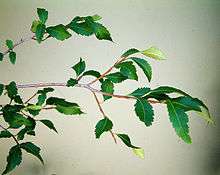Plagianthus regius
| Ribbonwood/manatu | |
|---|---|
| | |
| Lowland Ribbonwood | |
| Scientific classification | |
| Kingdom: | Plantae |
| (unranked): | Angiosperms |
| (unranked): | Eudicots |
| (unranked): | Rosids |
| Order: | Malvales |
| Family: | Malvaceae |
| Genus: | Plagianthus |
| Species: | P. regius |
| Binomial name | |
| Plagianthus regius (Poit.) Hochr. (1907) | |
Plagianthus regius or lowland ribbonwood is a tree that is endemic to New Zealand.[1] The common name is simply ribbonwood. The Māori name is manatu but is also known as houi, manaui manatu, puruhi and whauwhi.
The juvenile form has bushy interlacing branches with small leaves, while an older tree will tend to have larger leaves, sometimes with the lower parts of tree still displaying divaricating leaves.
A profusion of small white or green flowers appear in dense clusters in spring making it easier to distinguish from the similar lacebark family.
One of the distinctive aspects of this tree is that it is usually deciduous which is unusual for New Zealand, although in the northern areas it can be semi-deciduous. [2] It is considered the largest of New Zealand's deciduous trees growing to 6 metres. [3]
It grows in the North, South and Stewart Islands.
A subspecies from the Chatham Islands, Plagainthus regius subsp. chathamicus, is very similar but lacks the divaricating aspect.[4]
See also

References
- ↑ Melville, R. 1966: "Contributions to the Flora of Australia: VII. Generic Delimitation in the Plagianthus Complex." Kew Bulletin 20: 511-516
- ↑ http://www.nznativeplants.co.nz/shop/Native+Plants+by+Botanical+Name/Plagianthus+regius.html
- ↑ http://www.forestflora.co.nz/Plant%20profiles/Plagianthus%20regius.htm
- ↑ http://nzpcn.org.nz/flora_details.asp?ID=1142
| Wikimedia Commons has media related to Plagianthus regius. |